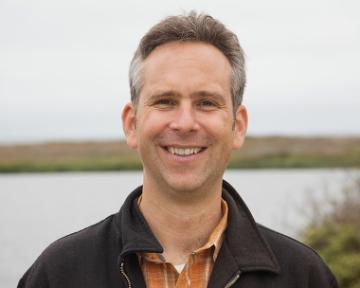
Environmental Justice: Historical Roots and Empowered Partnerships To Advance Research and Social Change
Reflections from the 2016–18 Bannan Institute Faculty Collaborative

By Christopher Bacon
Associate Professor, Department of Environmental Studies and Sciences
Bannan Faculty Fellow, Ignatian Center for Jesuit Education
Santa Clara University
Environmental Justice is a social movement’s demand for change, a field for interdisciplinary scientific inquiry, and an emerging area of government policy that can be defined as the right to healthy, livable communities for all people, where they live, learn, work, eat, play, and pray.
First, we’re talking about the right to recognition. Do all individuals count everywhere as a person before law and society? Second, we’re talking about distributive justice. Do all people have equal protection from environmental hazards (e.g., protection from high exposure to toxic chemicals and pesticides) and equal access to environmental benefits (e.g., clean air, drinkable water, and neighborhood parks)? We’re also talking about procedural justice. Do all people have avenues to participate fully in decision-making via a seat at the table? Finally, many of us are starting to include restorative justice and reconciliation. How do we repair the environmental inequalities we’ve inherited from the past and remake our relationships with each other and nature?
Although environmental justice (EJ) emerged from different historical roots, the National People of Color Environmental Leadership Summit in 1991 established a common definition and key principles. Part of the EJ movement started when North Carolina’s government attempted to dump carcinogenic polychlorinated biphenyls (PCBs), spilled by Ward Transformer in the 1970s, into one of Warren County’s lowest-income communities that was home to 75 percent AfricanAmerican residents; local residents organized and united with civil rights leaders to protect their families from tap water contamination. Researcher Robert Bullard subsequently showed that waste disposal sites in North Carolina and across the U.S. were more likely to be located in communities with elevated poverty rates and high densities of racial and ethnic minorities, sounding a national alarm on environmental racism.
This history inspired the Santa Clara University faculty participants in the Bannan Institute’s Environmental Justice Collaborative (EJC). For example, Professor Tseming Yang’s research explores how the 1964 Civil Rights Act could play a more significant role in shaping environmental policy by mandating careful consideration of marginal community voices and moving toward corrective environmental justice. Jasmín Llamas is another EJC member studying air pollution risks and potential strategies to reduce indoor exposures in San Jose. Her research links public health concerns related to consumption of dangerous products and disproportionate exposure to tobacco smoke among children in low-income households.
Environmental justice is also concerned with fair access to environmental and health benefits like food—thus food justice becomes the right to healthy, livable food systems for all people. Many facing food insecurity today are small farmers and food workers. As César Chávez said decades ago, “It’s ironic that those who till the soil and harvest the fruits, vegetables, and other foods that fill your tables with abundance have nothing left for themselves.”1
But farmers are not passive victims silently suffering seasonal hunger. For example, in the heart of Central America’s mountainous coffeegrowing regions, Nicaraguan producer Don Felipe is diversifying his farm, sharing practices with neighbors and strengthening his cooperative in the face of drought, low coffee prices, and crop disease.

Josh MacPhee, “Agua Para Todos!” 2016.
Three EJC projects confront the hungry farmer paradox and learn from the sustainable farmers in Nicaragua (Iris Stewart-Frey, Ed Maurer, and myself study agriculture and food and water security during climatic and market disruptions.) Long-term partnerships that I established with cooperatives and organic farmers now benefit from wider insights thanks to Iris Stewart-Frey’s research, which maps and analyzes climatic variability and local water systems, and through Ed Maurer’s assessment of how climatic change could alter precipitation patterns during the “hungry season.” Local partners can use our findings to adapt to climate change, while we are proposing new farmer-relevant metrics for climate science research.
However, many farmers are neither partnered with researchers nor responding like Don Felipe. Unable to make ends meet on the farm, they often seek employment on larger plantations, applying pesticides without protective measures. Here they face an unfair dilemma—choosing between poverty or poison.
Farmworkers in California’s Central Valley were facing both poverty and poison in the 1950s and 1960s, when United Farm Workers (UFW) co-founder, Dolores Huerta, started organizing for better wages and against disproportionate environmental exposures. This advocacy paved the way to establishing stricter regulation protecting workers from pesticide exposures.
In addition to these policy changes, UFW and collaborating scientists helped society understand pesticides as a public health issue, while simultaneously prompting the public health sciences to recognize pesticide exposure as a political and economic issue related to the immigration status of farmworker labor. These events represent a second—and often underappreciated—root of the EJ movement and a contribution to our common health and well-being.
It is worthwhile to remember that in addition to clean air and safe water, common goods include civic dialogue and the search for truth itself. In the tradition of philosopher John Rawls, we must also recognize that there are reasonable disagreements about what constitutes the common good and for this we have the rule of law, rights of free speech, and the correspondent duties of civic dialogue. Universities can serve the common good by opening spaces for these dialogues and evaluating the evidence and claims.
In his June 1982 commencement address at Santa Clara University, Ignacio Ellacuría, S.J., rector/president of the Universidad Centroamericana in El Salvador urged, “a university is inescapably a social force: It must transform and enlighten the society in which it lives.”2 The commitment to engage society and link solidarity to sustainability emerged with greater focus 27 years later, when Michael Engh, S.J., president of Santa Clara University, challenged the University to become “a champion of environmental justice—for the sake of and alongside the poorest in our world.”3 Six years later, Pope Francis reminded us: “In the present condition of global society, where injustices abound … the principle of the common good immediately becomes, logically and inevitably, a summons to solidarity.”4 Most recently, the energizing visit of Pedro Walpole, S.J., to SCU elaborated a strategy to form a community of practice rooted in justice, faith, and reconciliation.
Motivated by this call and our diverse dialogues, our Bannan Environmental Justice Collaborative plans to focus on empowered partnerships for environmental justice as a next step. To this end, Chad Raphael’s collaborative initiative is creating an open-source guide to fostering university-community partnerships for environmental justice. We will also convene a conference plan to use an Ignatian discernment process to shape networks that advance these partnerships.
After participating in the recent Bannan Institute Environmental Justice and the Common Good Roundtable Dialogue at Santa Clara University, Gustavo Aguirre from the Center on Race Poverty, and the Environment, reflected: “I want royalties, because you just told my life story.” He grew up with family farming in Mexico, migrated to the United States, and picked fruit in California’s Central Valley while organizing with César Chávez, and then worked with attorney Luke Cole to help establish the environmental justice movement in California. Universities can learn from the life stories of community leaders like Aguirre to help present and future generations achieve justice, reconciliation, and sustainability.
CHRISTOPHER BACON is an associate professor in the Department of Environmental Studies and Sciences at Santa Clara University. He completed his B.A. in economics and in environmental studies at UC Santa Barbara, and he received a Ph.D. in environmental studies from UC Santa Cruz. He completed postdoctoral studies in geography at UC Berkeley, before joining SCU in 2010. Bacon specializes in sustainable livelihoods and food security in Central America and environmental justice in California. He recently was awarded an NSF grant to study “Coping with Food and Water Insecurity in Nicaragua,” with several of his SCU colleagues.
Notes
- For more from César Chávez see United Farm Workers, Education of the Heart: Cesar Chavez in His Own Words, available at ufw.org/research/history/education-heart-cesarchavez-words.
- Ignacio Ellacuría, S.J., commencement address, Santa Clara University (June 1982), available at scu.edu/ic/programs/ ignatian-tradition-offerings/stories/ignacio-ellacuria-sjs-june1982-commencement-address-santa-clara-university.html.
- Michael Engh, S.J., inaugural address, Santa Clara University (April 24, 2009), available at scu.edu/president/selectedwritings/public-addresses/inaugural-speech.
- Pope Francis, Laudato Si’: On Care for Our Common Home, encyclical, (March 24, 2015), §158, available at w2.vatican. va/content/francesco/en/encyclicals/documents/papafrancesco_20150524_enciclica-laudato-si.html.
| Not a Roadmap but a Trail: Environmental Reconciliation with the Commons | Home | Explore, and You Will Discover |